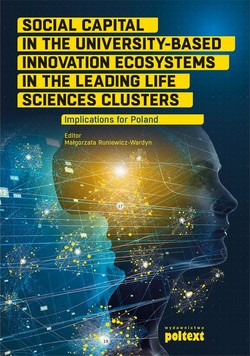Читать книгу Social Capital in the University-Based Innovation Ecosystems in the Leading Life-Science Clusters: Implications for Poland - Małgorzata Runiewicz-Wardyn - Страница 9
На сайте Литреса книга снята с продажи.
2. Defining Social Capital
ОглавлениеThere is also an ongoing process of the institutionalization of the category of social capital as an important factor influencing the social, economic and technological development of regions. Various authors provide similar and slightly distinctive definitions of social capital. Social capital is related to broadly understood formal and informal relations between at least two people. Positive social capital creates relationships based on trust, cooperation, openness, etc., negative capital refers to the social relations that are characterized by the suspicion, hypocrisy and secretiveness (Walukiewicz 2007). In his comprehensive study, Nan Lin (2001) defines capital, as “an investment of resources with expected returns in the marketplace” (Lin 2001: 3). Furthermore, he identifies social capital with such “products” as trust, shared values, and norms. A similar link to the private benefit resulting from social capital was mentioned by Pierre Bourdieu (1986), defining social capital as a private investment in social networks that brings the owner expected benefits, such as wealth, and “symbolic capital” (social position). James Coleman (1988), in turn, regarded social capital as an individual good that could be, however, traded through social networks for the advancement of broader human capital. Finally, the last two decades witnessed many new studies extending social capital from the individual or private good to more of a collective or even public good. This group of researchers include Fukuyama (2001), Putnam (2000), Rosenfeld (2007), Lin (2001), Landabaso et al. 2007, Woolcock and Narayan (2000) and others. According to Francis Fukuyama (2002), social capital is a set of informal norms and rules as well as ethical values shared by individuals and social groups that enable them to cooperate effectively. For Robert Putnam, social capital does not belong to anybody, but is a public good representing a set of social norms and civic attitudes supporting common actions and trust for both interpersonal and in public institutions (Bochniarz and Faoro 2016). Social capital is defined by experts from the European Commission (2005) in a similar manner – “Social capital refers to those stocks of social trust, norms and networks that people can draw upon to solve common problems”. In turn, the World Bank defines it as a set of “institutions, relationships, attitudes and values that govern interactions among people and contribute to economic and social development” (Grootaert and van Bestelaer 2002). The institutional and relational context is also present in Roberto Camagni’s definition of social capital, which is “the set of norms and values which govern interactions between people, the institutions where they are incorporated, the relationship networks set up among various social actors and the overall cohesion of society (…). [It] is the ‘glue’ that holds societies together” (Camagni and Capello 2012). The role of networks in the society was further extended in the comprehensive study by Franz Huber who proposes an interesting definition of social capital as “… resources embedded in social networks which can be potentially accessed or are actually used by individuals for action…” (Huber 2008: 19). Furthermore, he distinguishes “internal social capital” – resources mobilized through relationships between members of the collectivity – from “external social capital” – resources mobilized through relationships between members of the collectivity and actors outside of the collectivity. As an example of this dual character of social capital, Huber uses economic clusters, where the distinction depends on access to knowledge within the cluster and access to other clusters and outside individuals (Bochniarz and Faoro 2016). Philip Cooke adds the notions of reciprocity, trust and defines social capital “as the application or exercise of social norms of reciprocity, trust and exchange for political or economic purposes” (Cooke 2007: 102). He argues that knowledge-based industries are more engaged than others in building and performing social capital. Similarly, for Carlos Roman, social capital refers to a system of social relationships based on trust and working according to well-known rules (Landabaso et al., 2007). In turn, Stuart Rosenfeld interlinks the notion of social capital in clusters that gives opportunities to “know-who” to the notion of “know-how”. He also classifies social capital from the point of view of openness as positive and negative one (Rosenfeld 2007). Positive social capital creates economic advantages that are major forces for clustering. Negative social capital can develop when there are efforts to limit membership in clusters and cultivate insularity or “lock-in”. Finally, Cook and Rice (2006) in their chapter on the “social exchange theory” attempt to link social networks with social status, influence, solidarity, trust, affect and emotion. The authors emphasize the huge role of these connections and the macro-structures they create in the society.
To sum up, there is no common conceptual framework to the social capital concept. However, based on the above-quoted literature and for the purpose of the following study, social capital is defined as a type of capital that results from investments in building relations, institutions and networks that produce collaborative attitudes, shared norms and values as well as mutual understanding and trust.
